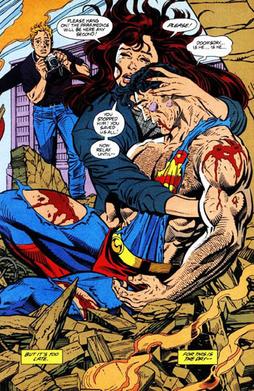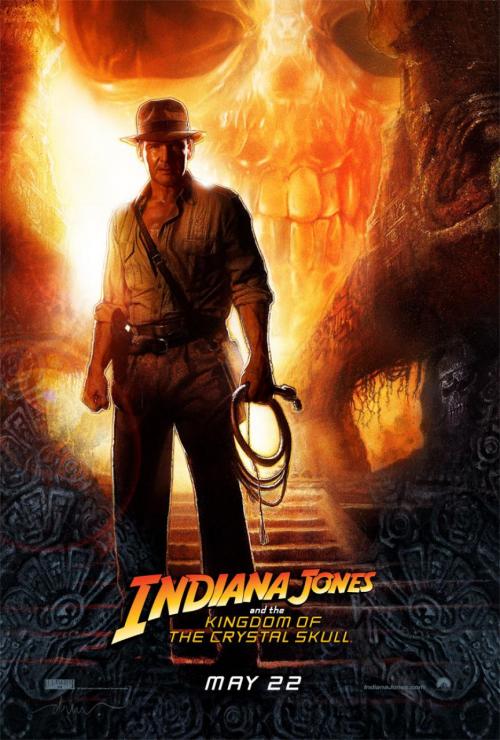
The comic book is an odd work of literature. In truth, its name is
graphic novel, but history has taught many to write it off as a one-dimensional story based in childish indulgence. This is often still the truth. Life is more easily viewed through the optimistic eyes of a child, where darkness is vanquished in the name of justice, and the world goes on without sacrifice.
However, the graphic novel is not always so simple-minded.
The superhero is an ideal: the concept of justice incarnate. Through the pages of so-called "comic books," stories are told that break the bonds of normality, allowing for the concepts of truth, justice, chaos, and evil to manifest as physical entities; as
heroes and
villains.
Nearly all comic book-based films follow the same basic plot: a hero is born, a villain rises, and the hero ends the rampage of the villain--often times with the villain dying by his own hand. Unfortunately, this formula is simple, and superhero films rarely make the attempt to create a wholly believable world in support of their tale. Perhaps to their detriment, this formula has become the staple of superhero stories. In many cases, however, graphic novels transcend this simple plot. As a result, modern myths emerge, and philosophical debates rage within the confines of ink and paper.
The Dark Knight is one such story.
While the costumes were not traditional superhero fare,
Batman Begins still followed the basic superhero film plot. What made it different, however, was the way that the film was presented. Rather than relying purely on suspension of disbelief, the film made every possible attempt to convince the audience that what was happening on the screen was real--that what was being shown was something that could actually happen. In a sense, the film fulfilled
Superman: The Movie's promise to make viewers "believe a man can fly."
The Dark Knight takes every element of
Begins to its fullest extent, going deeper and darker than any comic book film has ever dared to go.
This is not a film for the fainthearted. It is not made for children. Although its PG-13 rating is technically accurate to the level of on-screen content, the sheer level of realistic fear-inspiring imagery--although not gratuitous--is more befitting of an R rating. Although every child is different, and there are exceptions to every rule, my general statement is this:
children should not see this film.Much has been said about Heath Ledger's performance as the Joker. All the rumors are true; his performance is both flawless and terrifying. Any further discussion here would spoil the plot.
The film is expertly made. All possible plot holes are filled, though this does perhaps get in the way of the film's storytelling, as it requires immense amounts of dialogue that can be difficult to follow. The only other possibly negative aspect about the film's quality is the fact that the action scenes do not always allow the viewer a clear picture of what is happening. This is a deliberate move on the part of the director in order to keep the focus on the story rather than the action. It's an odd move for an action-heavy film, but it is ultimately serviceable.
The true power of the film, however, is not the cinematography, the acting, or the visual effects. Those elements are important and truly incredible in their own right, but are ultimately not the true value of the film. The film's true value is in its ability to make the viewer think; to harness the outlandish elements of fantasy, forge them into a frightening real-world image, and use them to delve into philosophical and sociological issues in ways that no other genre can.
The basic idea behind
The Dark Knight is that "things get worse before they get better." The events of
Batman Begins have caused a reaction within the city of Gotham. Batman's war on crime has upset the balance of power, and now criminals such as the Joker are appearing as a counterbalance to his influence. In truth, the crime in Gotham city is so powerful that it exists almost as a metaphysical entity. Batman represents hope for Gotham, but is a virus to its underworld. In this sense, the Joker exists as an antibody; the natural reaction of the underworld to the invading presence of Batman. The character of the Joker is simple: he is an agent of chaos. If Batman's goal is to bring justice and peace to Gotham, then the Joker is the personification of the destruction that Batman struggles to prevent. Perhaps the most interesting aspect of the dichotomy of these two characters is the fact that they both refuse to kill each other, simply because of their own personal philosophies. In truth, they represent opposite sides of the spectrum, and as long as one exists, so must the other. Ultimately, however, their battle is not for each other, but for the city.
The city of Gotham is treated almost as a character itself. If anything,
The Dark Knight's story is a dissertation on human sociology. Both Batman and the Joker have deep personal beliefs about society, and their battle against one another is perhaps more philosophical than physical. While Batman's goal is to act as a symbol, inspiring hope in the people of Gotham, the Joker simply wants to prove a point: that deep down, every human being is flawed and twisted. According to the Joker, all it takes is one bad day--one dark tragedy--to drive someone over the edge; to make them fall from the light.
This belief is what drives the Joker, and is therefore what drives the conflict of
the film. The good people of Gotham--Batman, Jim Gordon, and new D.A. Harvey Dent--work together to stop the Joker, each man with a slightly different approach as to exactly how it should be done.
- Batman acts as a symbolic vigilante, inspiring fear in the underworld.
- Jim Gordon acts as a courageous soldier in Gotham's war on crime, despite the fact that many of the men under his command are corrupt themselves.
- Harvey Dent acts as a political leader, inspiring hope rather than fear. Dent is Gotham's Shining White Knight, acting as a leader rather than a vigilante, working with the law rather than outside it.
The varying beliefs of the characters are tested through the many bloody conflicts that wage across Gotham, and it is only through these horrible battles that truth can emerge. This conflict is portrayed in so lifelike a manner that it cannot be simply dismissed as mere fantasy; it is a frighteningly realistic nightmare: a shadow of what could be.
Interestingly, the disturbing tone of the story mirrors the Batman character himself. In this way, the story of the film explores its main character in an epic sense, applying the events of the story to the architecture of Bruce Wayne's psyche. Batman is not the friendly neighborhood hero that Adam West so iconically portrayed decades ago. Though he does not kill, he strikes with cruelty and vengeance. He breaks the legs of injustice, crippling its foothold on the lives of the weak. He is a dark avenger, fighting not with the intent to heal, but to bring that which is corrupted to justice. If evil is alive, then Batman is the disease that will end that life. He is a silent protector, striking not from the light, but the shadows. He is
The Dark Knight.

 This movie is probably the most unrelentingly violent 103 minutes of imagery that I have ever seen.
This movie is probably the most unrelentingly violent 103 minutes of imagery that I have ever seen. For those who don't know the story or the character, let me break it down for you: Frank Castle is a man whose wife and child are brutally murdered by the mob. Having Special Forces experience, Castle becomes a vigilante, "The Punisher," hunting down and brutally killing not only those responsible for his family's murder, but mob bosses and criminals as a whole. The police have a love/hate relationship with The Punisher, as he technically commits murder, yet also takes down high-class mob bosses that the police can't get in jail.
For those who don't know the story or the character, let me break it down for you: Frank Castle is a man whose wife and child are brutally murdered by the mob. Having Special Forces experience, Castle becomes a vigilante, "The Punisher," hunting down and brutally killing not only those responsible for his family's murder, but mob bosses and criminals as a whole. The police have a love/hate relationship with The Punisher, as he technically commits murder, yet also takes down high-class mob bosses that the police can't get in jail.

























